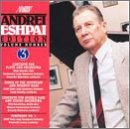| All Artists: Andrey Yakovlevich Eshpay, Alexander Vedernikov, Vassily Sinaisky, Gennadi Cherkasov, Constantin Ivanov, Moscow Conservatory Symphony Orchestra Title: Andrei Eshpai Edition, Vol.3 Members Wishing: 0 Total Copies: 0 Label: Albany Records Release Date: 2/22/2000 Genres: Pop, Classical Styles: Vocal Pop, Forms & Genres, Concertos, Symphonies Number of Discs: 1 SwapaCD Credits: 1 UPCs: 034061036722, 034061036722 |
Search - Andrey Yakovlevich Eshpay, Alexander Vedernikov, Vassily Sinaisky :: Andrei Eshpai Edition, Vol.3
 | Andrey Yakovlevich Eshpay, Alexander Vedernikov, Vassily Sinaisky Andrei Eshpai Edition, Vol.3 Genres: Pop, Classical
|
Larger Image |
CD Details |
CD ReviewsFolk and Jazz Inflections from the Post-Soviet World Thomas F. Bertonneau | Oswego, NY United States | 03/15/2003 (4 out of 5 stars) "The colorful music of prolific composer Andrei Eshpai (born 1927) is immediately attractive, so much so that any recording of his scores garners an automatic recommendation. Influences? Eshpai's ethnic origins lie in the Finno-Ugric Mari people, who, starting in 1918, found themselves incorporated (will they or nill they) in the Soviet Union. He has taken his musical cues from a number of sources - his own father (the first Mari composer), Bartók, Enescu, and Prokofiev. He also appreciates jazz. His music, recorded in the Soviet period by Melodiya, has appeared in the decade since national dissolution on CDs from Russian Disc and Albany, all of which I have assiduously collected as soon as I became aware of their existence. Eshpai cultivates the gamut of genres, having made a mark, on the one hand, as a serious symphonist and, on the other, as the author of effective concertos for solo instruments with orchestra. (He also wrote a jazz-inflected "Concerto Grosso" [1963].) The present disc shows up Eshpai's contribution to the solo-with-orchestra genre. The program begins with the Concerto for Flute and Orchestra (1992), in which the composer does not, as one might expect, pare down the accompaniment, but stipulates a full symphonic band, pitting the flutist against dauntingly large forces. The Flute Concerto conforms to Eshpai's practice of composing substantial one-movement works (in this case, eighteen minutes) whose plastic internal subdivisions correspond to the usual independent movements of the standard symphony or concerto. After the Eighteenth Century, there are not so many flute concertos. Eshpai's is warm, rich, and most welcome in the repertory. The Mari are related ethnically and linguistically to the Hungarians, the Estonians, and the Finns. Not surprisingly, Eshpai's melodies correspond, with his unique signature, to these references: the slow, sustained-note tunes are faintly reminiscent of Sibelius, while the dance-like ones put us in mind of Kodály or Bartók. So it is here. The opening cantilena for the solo, joined progressively but quietly by the accompaniment, in sparse textures, is Bartókian "night music." Dance elements mix with lyric elements. Eshpai makes good use of the vibraphone as added "color." The score called "Songs of the Mountain Mari" (1983) adds up to more than a suite; it is closer to a tone-poem on folk materials. This stands in a line with Russian musical exoticism going back to Borodin and is (or was) in accord with the directives of official Soviet "socialist realist" doctrine. Discussions of Eshpai often speak of his "natural conformism." Not being attracted to avant-garde styles, accepting nineteenth century models in form and harmony with a few added "modern" features, Eshpai never had to censor himself or bend against his will to the artistic demands of the totalitarian state, as did, for example, Prokofiev and Shostakovich in an earlier generation. Nevertheless, Eshpai's post-Soviet music dares a bit more than his earlier music. The Concerto for Double Bass and String Orchestra (1994-95) offers a case in point. This is Eshpai the connoisseur of jazz. Now admittedly the Soviet, or even post-Soviet idea, of jazz is hardly more advanced than Leonard Bernstein's mock "stride" style: yet this cheeky Concerto, clocking in at just over fifteen minutes, is hard to resist. It begins with improvisatory gestures from the double bass, ensues in a passacaglia and fugue, and ends in a lively, folk-and-jazz dance. Symphony No. 1, in two movements, dates from 1960; the recording dates from 1961, but it is in stereo. This is noticeably in the category of the "Soviet Symphony." It is hortatory, stentorian, heavy on the brass, but enjoyable for all that. The producers at Albany Records have drawn on a variety of sources in compiling this CD. The more recent performances are in good sound; but even the 1961 tape of the Symphony is adequate. This disc makes a good introduction to Eshpai. There have been some other Eshpai issues from Russian Disc - if they were still available, it would be worth searching them out as well. Recommended."
|

 Track Listings (5) - Disc #1
Track Listings (5) - Disc #1